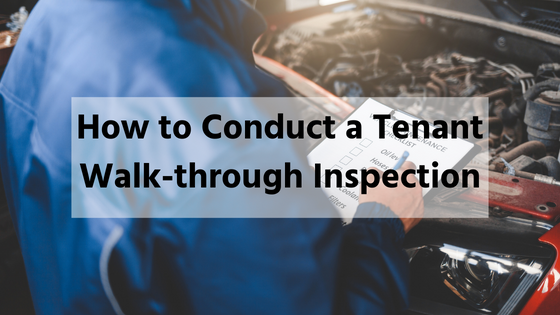How to Conduct a Tenant Walk-through Inspection
To keep your property in great shape and remain competitive in the rental property industry, landlords should regularly conduct inspections of their properties. Part of this process should include a walk-through inspection with your tenant at the beginning of their tenancy.
Another good reason to do a tenant walk-through inspection is to encourage the renters to do their part in maintaining the rental property. It isn’t solely the landlord’s responsibility to perform maintenance tasks, renters also have duties they need to perform.
When a rental property is in an outstanding condition, repair costs are minimal, which is a definite advantage for a property owner. Below is a list of steps for landlords to follow when doing a tenant walk-through inspection.
Create a Checklist
You can’t expect yourself to remember each detail of the property. You need to create a form that lists the different rooms of the rental property. Leave some space to write down detailed notes on any damage or wear and tear you observe in each room. It is simple to create one, but you can also base this form on online templates.

You can make it easy to keep track of the details by creating a list that includes the doors, windows, floors, walls, appliances, and any furnishings. Include a column for move-in and move-out conditions and estimated cleaning and repair fees, so it’s easy to see the state of each item at a glance and determine what’s damage beyond normal wear and tear.
Don’t forget to include a space where both you and your tenants can sign to indicate an agreement with the state of the property. Include the date and give your renter a copy of the form for reference.
Make It a Joint Rental Property Inspection
Before the tenants move in, you should schedule a tenant walk-through inspection since this ensures you are both on the same page when it comes to the state of the rental unit. It makes it easier to maintain a peaceful landlord-tenant relationship as it helps avoid conflicts.
This is also a good time to talk with the renters about your expectations on property maintenance. You can tell them about the cleaning standards and how to address normal wear and tear.
Some renters might also need more information on how to differentiate natural wear and tear from unexpected or unreasonable damage. It will help them learn which damage will affect their security deposit.

Simplify the Inspection Process
Your tenant walk-through inspection should be straightforward. It should be done in 20 minutes or less. It should also aim for concise inspections, including minor scuffs on the walls. This documentatio serves to protect tenants from being held accountable for pre-existing damage or wear and tear that they didn’t cause.
Document the Walk-through Inspection
Record the inspection with photos and videos. You can use your mobile device and start by taking a wide shot to capture the entire area, then narrow down the details with close-up images. Make sure that dates are stamped on the photos. Keep these images organized and ensure you have a backup digital copy.
If you intend to film the whole tenant walk-through inspection, you must ask permission from the renter first. Remember that documentation is essential for evidence since, without proof, it will be hard to defend your claim in case of legal issues.
Do a Property Check before the Tenant Arrives
Walk-through inspections are expected to be done in detail. It does not mean looking at superficial items such as stains and minor damages. Landlords can run tests on home systems beforehand to check whether they’re working properly. Making sure that appliaciances are in good working condition can also lead to a positive landlord-tenant relationship.

You can do the following tests:
- Flush toilets to evaluate the water pressure
- Check the condition of the heating and cooling systems
- Switch on appliances to assess if they are functional
- Open and close the doors and windows
Cultivating trust starts by delivering a habitable rental space to the new tenants. Performing testing leads to ensuring that you’re turning over a well-maintained unit.
Provide a Grace Period for the Renter to Report Potential Issues
Set aside a minimum period for renters to discover any property issue that may not have revealed itself when you performed prior testing. The grace period can be up to three days. This practice builds goodwill since it allows the renters to report valid concerns you may not have noticed. Document this issue and coordinate for repairs right away.
Familiarize Yourself with the Landlord-Tenant Laws in Your State
As a landlord, you are expected to know the state laws governing rental properties. Ensure that you comply with the conditions as you are doing a tenant walk-through inspection. The landlord-tenant laws also provide detailed guidelines on security deposit laws, landlord and tenant rights, landlord and tenant responsibilities, and evictions among others.
Avoid breaking these stipulations since it can lead to paying a fine or a lawsuit, which can result in financial loss.
Bottom Line
A tenant walk-through inspection is a great practice to limit future issues and ensure that both the landlord and renter have an accurate picture of the property’s state at the beginning of a new tenancy. A form is needed so no details are overlooked, but landlords should keep the inspection within a reasonable time frame.
If you need the support of a reliable property management company to perform walk-through inspections, contact IPM Property Management LLC today!

